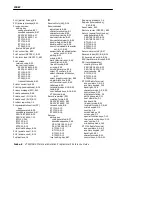
INDEX
"
Index-10
VT220/ANSI Terminal Emulation Programmer’s Reference Guide
Shift in (SI), 8-5
Shift key, PEN*KEY 6500, 7-7
Shift out (SO), 8-5
SI (LS0), 8-17
SI (shift in), 8-5
Single shift 2 (SS2), 8-9
Single shift 3 (SS3), 8-10
Single-width line (DECSWL),
8-28
Smooth scrolling, 8-20
SO (LS1), 8-17
SO (shift out), 8-5
Soft character sets, 8-15
Soft terminal reset (DECSTR),
8-45
SOH (start of heading), 8-5
SPA (start of protected area),
8-10
Space bar (special function key)
code generated, 8-56
PEN*KEY 6400, 6-16
PEN*KEY 6500, 7-10
RT1100, 3-11
RT1700, 4-14
RT3210, 2-11
RT5900, 5-11
Space compression, 8-62
Special function keys
codes generated, 8-56
PEN*KEY 6400, 6-15
PEN*KEY 6500, 7-9
RT1100, 3-10
RT3210, 2-10
RT5900, 5-11
Special graphics character set,
8-11–8-12
SRM (send/receive), 8-19
SS2 (single shift 2), 8-9
SS3 (single shift 3), 8-10
SSA (start of selected area), 8-9,
8-65
ST (string terminator)
extended commands
Receive Only, 9-20
Return Version, 9-28
Scan Bar Code, 9-42
Set Parameters, 9-26
Transmit and Receive, 9-3,
9-9
Transmit Only, 9-11, 9-15
received code, 8-10
user-defined keys, 8-37, 8-41
Standard keys
codes generated, 8-56
PEN*KEY 6400, 6-12, 6-13
PEN*KEY 6500, 7-8
RT1100, 3-9
RT1700, 4-11
RT3210, 2-9–2-10
RT5900, 5-9
Start of heading (SOH), 8-5
Start of protected area (SPA),
8-10
Start of selected area (SSA), 8-9,
8-65
Start of text (STX), 8-5
Straight 2of5, 9-40
String terminator (ST)
extended commands
Receive Only, 9-20
Return Version, 9-28
Scan Bar Code, 9-42
Set Parameters, 9-26
Transmit and Receive, 9-3,
9-9
Transmit Only, 9-11, 9-15
received code, 8-10
user-defined keys, 8-37, 8-41
STS (set transmit state), 8-10
STX (start of text), 8-5
SUB (substitute), 8-6
Substitute (SUB), 8-6
Supplemental graphics char-
acter set, 8-7–8-8
Symbols.
See Annunciators
SYN (synchronous table), 8-6
Synchronous table (SYN), 8-6
SysReq key, 7-5
T
Tab
local editing key, 8-67
special function key
code generated, 8-56
PEN*KEY 6400, 6-16
PEN*KEY 6500, 7-10
RT1100, 3-11
RT1700, 4-14
RT3210, 2-11
RT5900, 5-11
terminating key, 8-54
Tab stops (received code), 8-25
Tables
bar code string formats, A-3
C0 control characters, 8-4–8-6
C1 control characters,
8-8–8-10
character sets
Greek, 8-14
multinational, 8-4, 8-8
national replacement, 8-13
special graphics, 8-12
escape sequences, 9-46
GL characters, 8-4
local edit mode, 8-62, 8-67
PEN*KEY 6400
auxiliary keys, 6-19
editing keys, 6-17
special function keys, 6-16
standard keys, 6-12, 6-13
control keys, 6-22
top-row function keys, 6-21
PEN*KEY 6500
auxiliary keys, 7-13
editing keys, 7-11
special function keys, 7-10
standard keys, 7-8
control keys, 7-14
top-row function keys, 7-14
received codes
cursor positioning, 8-23
device attributes, 8-43
device status reports, 8-44
double-height line, 8-28
double-width line, 8-29
down-line loadable char-
acter set, 8-42
editing sequences, 8-30
erasing, 8-32
hard character set, 8-15
Summary of Contents for VT220/ANSI
Page 4: ......
Page 18: ...CONTENTS xiv VT220 ANSI Terminal Emulation Programmer s Reference Guide...
Page 26: ...SECTION 1 Introduction 1 8 VT220 ANSI Terminal Emulation Programmer s Reference Guide...
Page 264: ...APPENDIX A Bar Code Scanning A 4 VT220 ANSI Terminal Emulation Programmer s Reference Guide...
Page 276: ...INDEX Index 12 VT220 ANSI Terminal Emulation Programmer s Reference Guide...



































